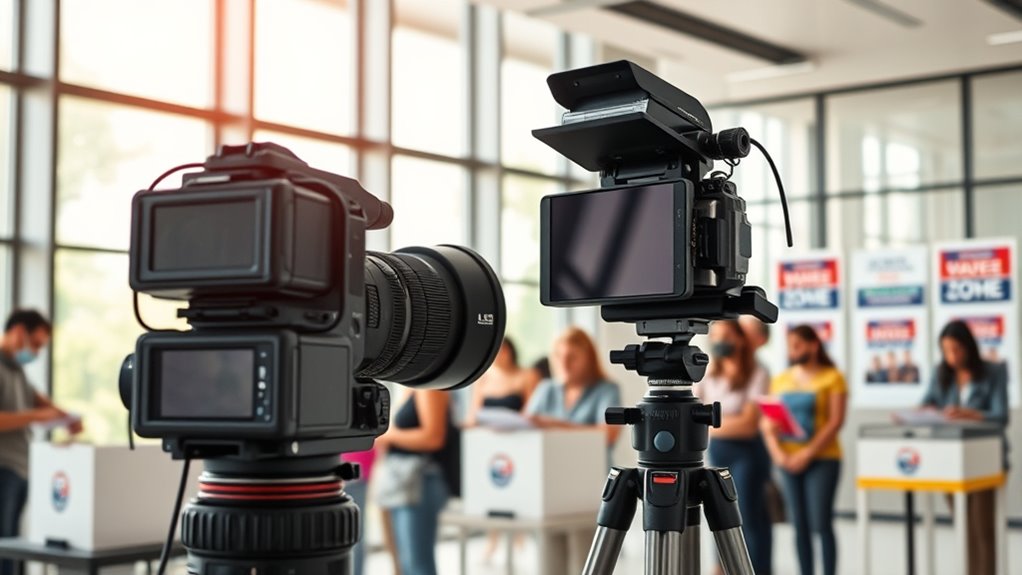Political science polling measures voter opinions and predicts election outcomes by analyzing patterns and trends over time. To be accurate, polls need proper sample sizes, representative groups, and carefully worded questions. Keep in mind, small differences often reflect sampling errors, and no single poll gives a full picture. Understanding margins of error and trends helps you interpret results more critically. To discover how these factors shape reliable polls, explore further details below.
Key Takeaways
- Polling measures public opinion and predicts election outcomes by analyzing voter behavior and opinion trends over time.
- Accurate polling depends on representative samples, proper question wording, and minimizing bias.
- Results include margins of error, indicating potential variation and uncertainty in voter support estimates.
- Trends across multiple polls provide better insights than individual results, which can be affected by sampling error.
- Polls are snapshots of public opinion, not definitive forecasts, emphasizing the importance of understanding their limitations.

Have you ever wondered how political opinions are measured and interpreted? Understanding this process begins with examining how pollsters gather and analyze data about voter behavior. Polling is more than just asking people who they plan to vote for; it involves sophisticated methods to predict election outcomes and gauge public sentiment. When you see poll results, remember that their accuracy depends heavily on how well they reflect the true voter behavior. Polling accuracy isn’t guaranteed—it’s influenced by factors like sample size, question wording, and how representative the sample is of the broader population. Accurate polls aim to mirror the diversity of voters, capturing different demographics, regions, and viewpoints to produce reliable estimates. If a poll’s sample skews heavily toward one group, the results may be misleading. That’s why reputable polling organizations spend considerable effort designing their studies to minimize bias and maximize precision.
Voter behavior is complex, and understanding it requires more than just tallying preferences. Pollsters analyze patterns, trends, and shifts in opinions over time, providing insights into what influences voters’ decisions. For example, economic issues, social concerns, and candidate traits can all sway voter behavior. When polls track these changes, they help campaigns and analysts understand the dynamics of an election. But it’s essential to interpret these results carefully. Small differences in polling data can sometimes reflect sampling error rather than a true change in voter sentiment. That’s why polling accuracy is indispensable—if polls are off, they can mislead campaigns, media, and the public about the likely outcome. Recognizing the limitations of polling helps you see that no single poll tells the whole story; instead, trends across multiple polls give a clearer picture of voter behavior. The quality of a poll’s sample and methodology directly impacts its accuracy and reliability.
Pollsters use statistical techniques to adjust for potential biases and improve accuracy, but even well-conducted polls have margins of error. This margin indicates how much the results could vary if the entire population were surveyed instead of just a sample. When you see a poll showing a candidate with 48% support and a margin of error of ±3%, it means the true support could be as low as 45% or as high as 51%. Understanding these nuances helps you interpret polling results more critically. Ultimately, the goal of political science polling is to provide a snapshot of voter behavior at a given moment, but it’s not a crystal ball. Careful analysis and an awareness of polling accuracy help you see beyond the headlines and understand the real pulse of public opinion.
Frequently Asked Questions
How Accurate Are Political Polling Predictions?
Political polling predictions are generally accurate but aren’t perfect. You should know that sampling errors can skew results if the sample isn’t representative, and response biases might lead people to give socially desirable answers instead of honest ones. While polls give a good snapshot of public opinion, always consider these factors. No prediction is foolproof, but understanding these issues helps you interpret poll results more critically and accurately.
What Are Common Biases in Polling Methods?
You should know that common biases in polling methods include sampling errors, where the sample isn’t representative of the population, and question wording, which can influence responses. These biases can skew results and lead to inaccurate predictions. To improve accuracy, guarantee your sample reflects diverse demographics and craft neutral, clear questions. Recognizing these biases helps you interpret poll results more critically and understand their limitations.
How Does Sample Size Affect Polling Results?
When considering how sample size affects polling results, larger samples reduce the sampling margin of error, making your results more precise. This increases the likelihood of achieving statistical significance, meaning your findings are more reliable and representative of the whole population. Conversely, small samples can lead to higher margins of error, potentially skewing results. So, a bigger sample generally provides more confidence in your poll’s accuracy and insights.
What Ethical Concerns Exist in Political Polling?
You might wonder if political polling raises ethical concerns, and it does. Privacy violations are a major issue, as respondents’ personal data can be mishandled or misused. Additionally, ensuring informed consent is crucial; participants should know how their data will be used. When these ethical standards aren’t met, trust erodes, and poll results become less reliable. So, maintaining transparency and respecting privacy are essential for ethical polling practices.
How Can Polls Influence Voter Behavior?
Polls can profoundly influence your voting behavior by shaping campaign strategies and media influence. When polls show a candidate leading, you might feel assured or discouraged, affecting your motivation to vote. Campaigns often adjust their messaging based on poll results, targeting specific voter groups. Media coverage amplifies these effects, possibly swaying your perception of candidate popularity and importance, ultimately guiding your decision at the polls.
Conclusion
So, stay skeptical and scrutinize survey strategies. Recognize the risks, remember the relevance, and refine your research rigor. Political polling paints a picture, but it’s your responsibility to decode details and discern data’s depth. Don’t depend solely on numbers; explore into the data’s dynamics. By balancing belief and skepticism, you’ll better understand polls’ power and pitfalls. Stay sharp, stay savvy, and see through superficial statistics—success depends on your skill to scrutinize surveys smartly.










